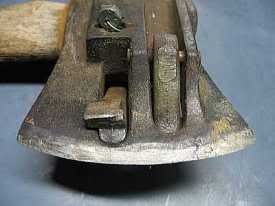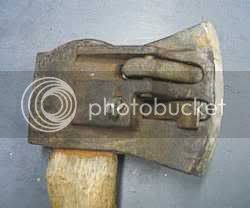While I am not a physicist, I am an engineer. I see you point with the KE, however I am not sure if it applies to splitting wood as much as force, think about it when you buy a mechanical wood splitter do you buy it for its KE value or the force (tons) it applies to the wood. It is really force we are talking about here and if you are interested in KE and momentum then you can see that a heavier object at a much slower speed has a much higher KE then a small object at a very high speed. The basic example a ping pong ball going 300 mph or a 5 pound rock going 30 mph which rather you get hit by they have the same KE, but I rather take my chance with the ping pong ball.
And JamesJems, you can not swing an 8 lbs ax twice as fast as a 16 pound ax and there is no way you can swing an 8 pound ax 3 times as fast as a 16 pound ax. I get your point about the object not reaching terminal velocity of 32ft/sec/squared but gravity is working on both object and both objects will reach about the same speed due to gravity. Which in this case let say is 1/4 of the terminal velocity. In general, a speed of 50% of terminal velocity is reached after only about 3 seconds, while it takes 8 seconds to reach 90%, 15 seconds to reach 99% and so on. In general on earth under normal non-vacuum condition terminal velocity is around 120 mph or 175 feet per second so let say our ax/maul is moving at 1/4 of this or 40 ft/second or 30 mph due to gravity alone and both ax/mauls are moving at the same speed.
Now think about it how fast can you real swing your ax from the top of the swing to the time it takes to hit the wood, low long does it take, 1/2 a second,1/4 a second? Basically if you can swing an 8 pound ax in 1/4 a second does it really take you a full ½ a second to swing a 16 pound ax or could you swing a 4 pound ax in 1/8 of a second NO it is not psychically possible. This is why a 20 pound monster maul works, because even if you in part no effort to the swing just basically drop it (let gravity alone do all the work) it does not take 2.5 times longer for the maul to fall compared to how fast you can swing a lighter ax. So even if you have a quick swing and it takes 1/4 a second to swing an 8 pound ax, it does not take 0.625 of a second for the 20 pound maul to drop. Just try it for you self lift an object over you head and drop it, it takes less than ½ a second for it to hit the ground. Just for the record according to timber sports it takes a little more than ¼ of a second to swing an ax on average which mean even if you do put any effort in your swing you are imparting almost as much force with a 16 pound ax as you do full force swing with a 8 pound ax.
JamesJems bring up another issue how much force do you need for 10 inch round, yes a 16 pounder is a bit of over kill, and there are two parts of a swing the first part the lift, which is much quicker and easier with a smaller ax then with a monster ax and that your cycle time is faster even if your swing speed is about the same and with smaller wood you can split faster and with less effort with a small ax then with a big one, but if you split bigger wood like I do (16 in tend to be the minimum tree size and 20 inch or larger is common) more force is need and you can split much faster with a bigger ax.


























































